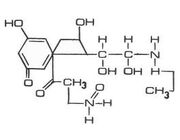
Chemical Makeup of Cordrazine
Cordrazine was a strong chemical stimulant created on Earth in 1987. It is classified as a "autonomic nervous system stimulant" by Starfleet Medical.
It was originally used in cryogenic laboratories to stimulate production of epinephrine and norepinephrine in the Human brain, allowing nerve transmission to be restored to the frozen body. (TOS reference: Star Fleet Medical Reference Manual)
By the 24th century, a more potent form of cordrazine had been developed, tricordrazine. (TNG episode: "Ethics")
Effect on Body[]
It creates an increase in myocardial contraction due to an influx of calcium into the fibers, resulting in a more complete emptying of the ventricles and an increase in cardiac work plus oxygen consumption. It also stimulates the production of natural occuring epinephrine and norepinephrine at the myoneural junctions and autonomic synapses in the brain.
It is specifically used for:
- Reviving nerve impulse transmission in the brain
- Increasing myocardial contraction, Purkinje fiber effect, speeding up the heart in times of heart failure or heart flutter.
The standard dosage for Humans is 0.25 cc. Taking it also comes with a number of side effects, including: elevated blood pressure, dry mouth, tachycardia, restlessness, insomnia, irritability, increased anxiety, paranoia, and death if overdosed. (TOS reference: Star Fleet Medical Reference Manual)
Despite these effects, it was used by Starfleet doctors in the 23rd century during emergency medical situations, primarily to stimulate the heart during cardiac arrest.
Cases[]
Prior to the late 23rd century, there had been a number of incidents involving the usage of cordrazine. In Stockholm, Sweden, a researcher accidentally ingested large quantities of the drug and immediately began to feel his was under attack. He barricaded himself in his laboratory, and when colleagues were able to force their way in, they discovered that a chemically explosive trap had been set for them, resulting in the death of seven, and injuries to twenty-three others.
In another episode, a disturbed individual took a quantity of cordrazine to commit suicide, but instead of dying he found he had lost the memory of anybody he had ever known. He was eventually found dead a few weeks later after killing himself with a phaser.
In a further case, a physician from the University of Alpha Centauri had become subjected to a high dosage of cordrazine in unknown circumstances. She was found unconscious by colleagues and taken to a nearby hospital, from where she subsequently vanished. Five months later, her body was found in a public bar in the city of Englantine on Stygian III.
Another case saw a cabaret dancer from Rigel II being found dead in a dressing room, after a jealous patron injected her with a large dosage of cordrazine. A criminal trial later saw the murderer being sent to prison.
In the 2250s, a landing party from the USS Farragut had to take a three-day hike across a mountainous region on an unspecified planet. Part way into the hike and older officer suffered a heart attack, and the medical technician present saw no choice but to inject the officer with a minute dose. Unfortunately, the officer died instantly. (TOS - Crucible novel: The Fire and the Rose)

Dr. McCoy after injecting himself with cordrazine
One example of excessive amounts of cordrazine being known to cause temporary dementia and violent paranoia was in 2267, when Dr. Leonard McCoy had been summoned to the bridge after a short circuit at the helm console injured Lt. Hikaru Sulu. McCoy decided to risk a few drops of cordrazine, despite Captain Kirk's concerns that it was "tricky stuff." After reviving Sulu with a couple drops of cordrazine, McCoy was standing at the helm console, checking his hypospray when the ship was hit by a shock wave. Trying to hold himself steady, McCoy accidentally pushed the hypospray into his mid-section, and injected himself with all the cordrazine remaining in the hypospray. After waking up in an agitated state, he immediately suspected that his crewmates were trying to kill him, and escaped to the planet Gateway. (TOS episode: "The City on the Edge of Forever"; TOS novel: The Klingon Gambit)
In 2268, Ensign Rizzo lay in critical condition in sickbay aboard the USS Enterprise following an attack by a dikironium cloud creature. James T. Kirk asked Leonard McCoy to revive the dying officer for a moment to confirm suspicions about the cloud. McCoy ordered Christine Chapel to inject 1 cc of cordrazine into him, which woke him up for a minute. (TOS episode & Star Trek 9 novelization: Obsession)
Other[]
Doctor Sarjenka once joked that she used a cordrazine to help wake herself up mornings. (CoE eBook: Troubleshooting)
Appendices[]
Background[]
The invention date of 1987 comes from the 1977 reference book Star Fleet Medical Reference Manual. As of this writing, no such chemical has in fact been developed, and the provided structure would require many atoms to bond with far more other atoms than they're typically capable of, and would thus almost certainly be extremely unstable if it could be produced at all. Cordrazine was also referenced (as a real chemical) in the TV series Mission: Impossible.
References[]
- TOS comic: "We Are Dying, Egypt, Dying!" (misspelled cordazine)
External link[]
- Cordrazine article at Memory Alpha, the wiki for canon Star Trek.
